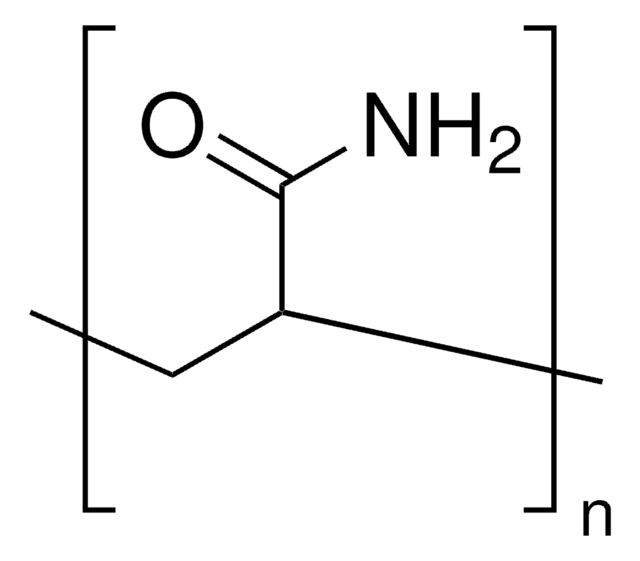01696
Acrilamida
for Northern and Southern blotting, powder blend
Sinónimos:
2-Propenamida, Amida del ácido acrílico
About This Item
Productos recomendados
grado
for molecular biology
Nivel de calidad
densidad de vapor
2.45 (vs air)
presión de vapor
0.03 mmHg ( 40 °C)
Línea del producto
BioReagent
Análisis
≥99.5% (GC)
formulario
powder blend
técnicas
electrophoresis: suitable
impurezas
DNases, none detected
RNases, none detected
phosphatases, none detected
proteases, none detected
bp
125 °C/25 mmHg (lit.)
mp
82-86 °C (lit.)
solubilidad
H2O: 0.25 g/mL at 20 °C, clear, colorless
temp. de almacenamiento
2-8°C
cadena SMILES
NC(=O)C=C
InChI
1S/C3H5NO/c1-2-3(4)5/h2H,1H2,(H2,4,5)
Clave InChI
HRPVXLWXLXDGHG-UHFFFAOYSA-N
¿Está buscando productos similares? Visita Guía de comparación de productos
Descripción general
Aplicación
Precaución
Producto relacionado
Palabra de señalización
Danger
Frases de peligro
Clasificaciones de peligro
Acute Tox. 3 Oral - Acute Tox. 4 Dermal - Acute Tox. 4 Inhalation - Carc. 1B - Eye Irrit. 2 - Muta. 1B - Repr. 2 - Skin Irrit. 2 - Skin Sens. 1 - STOT RE 1 Oral
Órganos de actuación
Peripheral nervous system
Código de clase de almacenamiento
6.1C - Combustible acute toxic Cat.3 / toxic compounds or compounds which causing chronic effects
Clase de riesgo para el agua (WGK)
WGK 3
Punto de inflamabilidad (°F)
280.4 °F - closed cup
Punto de inflamabilidad (°C)
138 °C - closed cup
Equipo de protección personal
Eyeshields, Faceshields, Gloves, type P3 (EN 143) respirator cartridges
Elija entre una de las versiones más recientes:
¿Ya tiene este producto?
Encuentre la documentación para los productos que ha comprado recientemente en la Biblioteca de documentos.
Los clientes también vieron
Protocolos
An introduction to both Northern and Southern blotting, popular methods for the transfer of macromolecules to membranous support. This article also offers a Southern blot protocol and a northern blot protocol.
Nuestro equipo de científicos tiene experiencia en todas las áreas de investigación: Ciencias de la vida, Ciencia de los materiales, Síntesis química, Cromatografía, Analítica y muchas otras.
Póngase en contacto con el Servicio técnico










